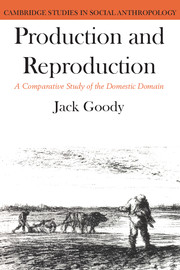Book contents
- Frontmatter
- Contents
- Tables
- Figures
- Preface
- Acknowledgements
- 1 The evolution of the domestic economy: the hoe and the plough
- 2 The theory, the variables and a test
- 3 Making causal inferences
- 4 Farming, labour and sex
- 5 Concubines and co-wives: the structure of roles in Africa and Eurasia
- 6 Adoption in cross-cultural perspective
- 7 Strategies of heirship
- 8 Class and marriage
- 9 Retrospect
- Appendix 1 Tables
- Appendix 2 The probability of family distributions
- Notes
- References
- Index
Appendix 2 - The probability of family distributions
Published online by Cambridge University Press: 05 June 2012
- Frontmatter
- Contents
- Tables
- Figures
- Preface
- Acknowledgements
- 1 The evolution of the domestic economy: the hoe and the plough
- 2 The theory, the variables and a test
- 3 Making causal inferences
- 4 Farming, labour and sex
- 5 Concubines and co-wives: the structure of roles in Africa and Eurasia
- 6 Adoption in cross-cultural perspective
- 7 Strategies of heirship
- 8 Class and marriage
- 9 Retrospect
- Appendix 1 Tables
- Appendix 2 The probability of family distributions
- Notes
- References
- Index
Summary
The following table illustrates the variations in the composition of families depending on the average size and the likelihood of a child dying before his father. For present purposes we assume that a ‘modern’ population is represented in the top left-hand corner, and a preindustrial one in the bottom right. The figure of one-third chance of a son succeeding his father corresponds roughly to pre-industrial conditions, the figure of two-thirds corresponds roughly to the contemporary situation. The families consist of couples who can have children; this figure represents approximately 95 per cent of married couples since about 5 per cent (the sterility figure is variable) are unable to have children and can therefore be added to the number of families with no heirs.
Assuming that populations were only increasing slowly before the advent of modern medicine, the average proportions of families with no heirs, with daughters only and with male heirs, would remain roughly the same over time. E. A. Wrigley estimates the proportion as 20:20:60. On the table below this figure would correspond to a family size of 6 with a one third chance of a son surviving a father (i.e. two-thirds chance of dying before his father), where the figures (before the 5 per cent adjustment) would read 12 (no heirs), 23 (daughters), 65 (male heir); corrected the figure would read 17:21:62.
- Type
- Chapter
- Information
- Production and ReproductionA Comparative Study of the Domestic Domain, pp. 133 - 134Publisher: Cambridge University PressPrint publication year: 1977



